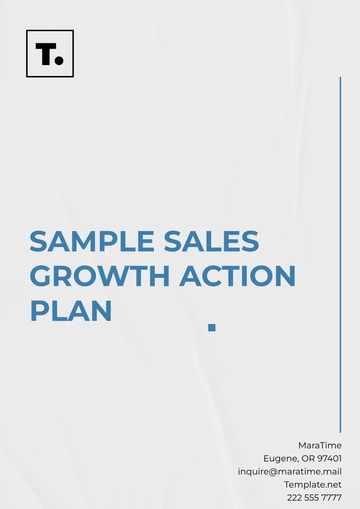Free Brand Action Plan

Prepared by: [Your Name]
Company: [Your Company Name]
Date: [Date]
1. Introduction
This Brand Action Plan outlines the strategic approach for strengthening and positioning our brand in the market. The plan aims to establish a compelling brand presence, drive customer engagement, foster long-term loyalty, and achieve measurable business outcomes. This plan sets a clear roadmap for success by aligning branding efforts with organizational goals.
2. Brand Analysis
2.1 Current Position
An assessment of the current brand position includes:
Market Share: A review of our existing market presence relative to competitors.
Target Audience: Key demographics, psychographics, and customer behaviors.
Competitive Landscape: Analysis of direct and indirect competitors, highlighting key differentiators.
Brand Perception: Understanding current customer perceptions and sentiments about the brand.
2.2 SWOT Analysis
A detailed SWOT analysis identifies key internal and external factors affecting the brand:
Strengths | Weaknesses |
|---|---|
Established reputation | Limited presence in new markets |
Strong customer loyalty | Inconsistent messaging across channels |
Quality product/service offering | Low digital engagement |
Opportunities | Threats |
|---|---|
Growing demand for digital solutions | Emerging competitors |
Expansion into untapped regions | Rapid shifts in consumer behavior |
Enhanced content and social media | Economic uncertainties |
3. Objectives
Clear, measurable objectives that align with business goals include:
Enhance brand recognition and recall by 20% within the next year.
Increase customer engagement across digital platforms by 30% within six months.
Expand market presence into three new regions by the end of the fiscal year.
Strengthen brand consistency across all touchpoints within six months.
Drive customer acquisition by 15% through targeted campaigns over 12 months.
4. Branding Strategies
4.1 Brand Identity Development
Refine Brand Elements: Update logos, taglines, typography, and brand colors to ensure a cohesive identity.
Brand Guidelines: Develop comprehensive brand guidelines for internal and external consistency.
Storytelling: Strengthen the brand narrative to communicate values, vision, and differentiators.
4.2 Content Marketing
Content Strategy: Develop engaging content tailored to target audiences across blogs, videos, case studies, and thought leadership pieces.
SEO Optimization: Implement SEO best practices to improve organic reach and visibility.
Content Calendar: Schedule content rollout to maintain consistency and align with key marketing campaigns.
4.3 Social Media Strategy
Platform Selection: Focus on platforms where the target audience is most active.
Community Engagement: Create interactive campaigns, respond to feedback, and encourage user-generated content.
Paid Campaigns: Implement paid social advertising to amplify reach and engagement.
4.4 Influencer and Partnership Marketing
Collaborate with relevant influencers and industry partners to enhance credibility and reach new audiences.
Develop co-branded initiatives to strengthen positioning in new and existing markets.
4.5 Customer Experience Enhancement
Ensure a seamless and consistent customer experience across all digital and physical touchpoints.
Implement feedback loops to gather customer insights and improve satisfaction.
Introduce loyalty programs to enhance retention and advocacy.
5. Action Plan
The following table outlines specific actions, timelines, and responsible teams to execute branding strategies:
Action | Timeline | Responsible Team |
|---|---|---|
Brand Identity Rebranding | Quarter 1 | Marketing |
Content Calendar Development | Month 2 | Content Team |
Social Media Campaign Launch | Ongoing | Social Media Team |
Influencer Marketing Partnerships | Quarter 2 | Marketing & Partnerships |
Customer Experience Audit | Month 3 | Customer Success Team |
SEO-Optimized Content Rollout | Ongoing | Content & SEO Teams |
Loyalty Program Launch | Quarter 3 | Customer Success & Sales |
Market Expansion Campaigns | End of Fiscal Year | Marketing & Sales Teams |
6. Budget Allocation
A breakdown of estimated budget allocation ensures resource optimization:
Category | Budget (%) |
|---|---|
Brand Identity Development | 20% |
Content Creation & Marketing | 25% |
Social Media Campaigns | 15% |
Influencer Partnerships | 10% |
Customer Experience Enhancements | 15% |
Market Expansion Initiatives | 15% |
7. Monitoring and Evaluation
To track progress and ensure objectives are met, the following KPIs and metrics will be monitored:
Objective | KPI/Metric | Evaluation Timeline |
|---|---|---|
Enhance brand recognition | Brand recall surveys, website traffic | Quarterly |
Increase digital engagement | Social media engagement rates, click-through rates | Monthly |
Expand market presence | New customer acquisition, regional sales growth | Biannually |
Strengthen brand consistency | Customer feedback, brand audit reports | Quarterly |
Drive customer acquisition | Conversion rates, lead generation | Monthly |
8. Risk Management
To mitigate potential challenges, a proactive risk management approach will be applied:
Risk | Mitigation Strategy |
|---|---|
Competitor disruptions | Continuous competitive analysis |
Budget overruns | Regular budget reviews and adjustments |
Low campaign engagement | A/B testing and content optimization |
Delayed timelines | Establish contingency plans |
9. Conclusion
This Brand Action Plan is a strategic blueprint to strengthen the brand’s market position, drive customer engagement, and achieve sustainable growth. This plan will ensure measurable success in alignment with overarching business objectives by executing targeted strategies, closely monitoring performance, and adapting to market changes.
Through consistency, innovation, and a customer-centric approach, the brand will solidify its position as a market leader and build long-term loyalty among its audience.
- 100% Customizable, free editor
- Access 1 Million+ Templates, photo’s & graphics
- Download or share as a template
- Click and replace photos, graphics, text, backgrounds
- Resize, crop, AI write & more
- Access advanced editor
Streamline your branding strategy with the Brand Action Plan Template from Template.net. Fully editable and customizable, this template ensures effortless planning and execution. Easily modify it using our Ai Editor Tool to suit your unique needs. Achieve clarity, consistency, and results with this user-friendly resource tailored for professional branding success. Start customizing your plan today!





























